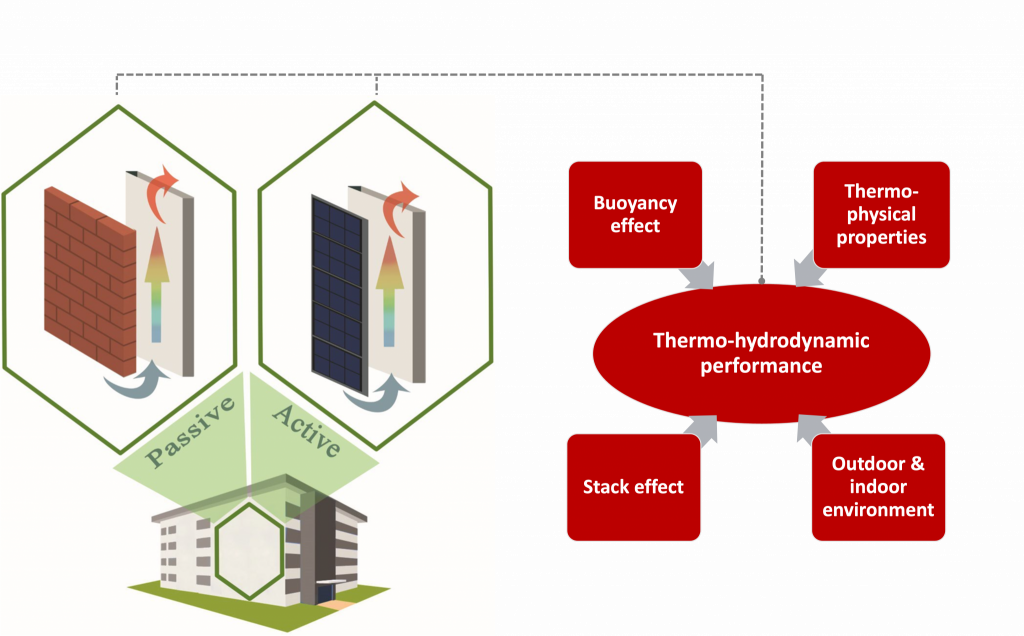PhD thesis “Impact of ventilated air-space behind traditional (passive) and BIPV (active) façades on the thermo-hydrodynamic performance of building wall structures” performed by Mohammad Rahiminejad (2018-2022).

Project Description
Heat losses through the building envelope, which includes the exterior walls, windows, roof, and foundation, account for approximately 30% of the primary energy used in residential and commercial buildings. Therefore, the building envelope plays a key role in reaching the worldwide climate-neutral policy by 2050, which is an economy with Net-Zero Greenhouse Gas Emissions.
Typically, external claddings are separated from the massive walls by an air-space that is formed due to the presence of battens or anchors to attach the cladding to the building envelope. Transient variations of the thermal and hydrodynamic performances of the airflow in the air gap can affect the heat flow entering/leaving the indoor space. Moreover, in the Building Integrated Photovoltaic (BIPV) façades, the airflow behind the PV panels needs to be exhausted to avoid the drop in electricity production at high surface temperatures. Meanwhile, the heat recovered from the PV panels can be purposefully used for preheating needs of the building contributing to the reduction of energy required for thermal conditioning of buildings (i.e., comfort conditioning and hygiene hot water production).
Thus, this research addresses one of the most important sustainability challenges in the built environment, i.e., the climate change issue, by reducing the energy demand in the buildings using a multi-parametric design of the wall assembly by accounting for the external cladding type, dynamic outdoor conditions, and thermo-hydrodynamic behavior of the airflow in the ventilated air-space. The transient response of the building associated with the thermal inertia used in the wall structure is also analyzed, considering the presence of the ventilated cavity behind various types of the external cladding.
Background
- Wind-induced and buoyancy driven flows are the key factors affecting the thermo-hydrodynamic performance of the building envelope
- A building with a high thermal mass is able to time-shift and flatten out heat flow fluctuations
- Advancement in Building Integrated Photovoltaics (BIPV) has converted the building façades into a new source of energy production
Methodology
- Step 1: Parametric study of the influential factors affecting the performance of the ventilated air-space
- Step 2: Simulations of the thermal and hydrodynamic behaviour of airflow behind traditional and BIPV facades
- Step 3: Measurements of the thermo-hydrodynamic performance of ventilated walls in a test facility
- Step 4: Define a strategy to design the optimized wall assembly with the lowest heat gain/loss
Goals
- Define the plausible definitions for the thermal resistance of the ventilated air-space
- Propose protocols for measuring the thermal resistance of a ventilated cavity in the steady-state condition using the hot box method
- Analyze the performance of ventilated walls with passive and active façades in transient mode via numerical simulations and experimental measurements
Results
- Detailed understanding of dynamic variation of the thermal resistance of vertical air-spaces behind claddings
- Comparison between the overall performance of the ventilated walls with traditional and BIPV façades
- Evaluate the heat recovery potential from the ventilated cavity for the subsequent use in the building
- Propose modifications for international standards to incorporate the effect of the ventilated cavity in the analysis
Journal Publications
- M. Rahiminejad, D. Khovalyg. Experimental study of the hydrodynamic and thermal performance of ventilated wall structures. Building and Environment. 2022.
- M. Rahiminejad, D. Khovalyg. Numerical and Experimental study of dynamic thermal resistance of ventilated air-space behind passive and active façades. Building and Environment. 2022.
- M. Rahiminejad, D. Khovalyg. Measuring the effective thermal resistance of ventilated air-spaces behind common wall assemblies. Science and Technology for the Built Environment. 2022, 28:3, pp.320-337.
- M. Rahiminejad, A. Pâris, H. Ge, D. Khovalyg. Performance of lightweight and heavyweight building walls with naturally ventilated passive and active facades. Energy & Buildings. 2022, 256.
- M. Rahiminejad, D. Khovalyg. Thermal resistance of ventilated air-spaces behind external claddings; definitions and challenges. Science and Technology for the Built Environment. 2021, 27:6, pp.788-805.
- M. Rahiminejad, D. Khovalyg. Review on ventilation rates in the ventilated air-spaces behind common wall assemblies with external cladding. Building and Environment. 2021, 190.
Conference Publications
- M. Rahiminejad, D. Khovalyg. Heat recovery from ventilated passive and active facades: A numerical case study. CLIMA 2022.
- M. Rahiminejad, D. Khovalyg. Thermal resistance of the ventilated air-spaces behind external claddings; theoretical definition and a parametric study. Journal of Physics Conference Series. 2021, 2069(1):012197.
- M. Rahiminejad, D. Khovalyg. In-situ measurements of the U-value of a ventilated wall assembly. Journal of Physics Conference Series. 2021, 2069(1):012212.
- M. Rahiminejad, C. Berquand, D. Khovalyg. Transient thermal response of opaque building envelope elements: EPFL campus case study. Journal of Physics Conference Series. 2021, 2042(1):012080.
- R. Schindelholz, M. Rahiminejad, A. Chatterjee, D. Khovalyg. Assessment of thermal and electrical performance of BIPV façades using simplified simulations. Journal of Physics Conference Series. 2021. 2042(1):012081.
- M. Rahiminejad, A. Paris, D. Khovalyg. Dynamic Thermal Performance of the BIPV Facades. ASHRAE Transactions. 2021, 127, 170-179.
- M. Rahiminejad, D. Khovalyg. Impact of the Ventilated Cavity on the Thermal Performance of Traditional Wall Structures. ASHRAE Transactions. 2021, 127, 187-195